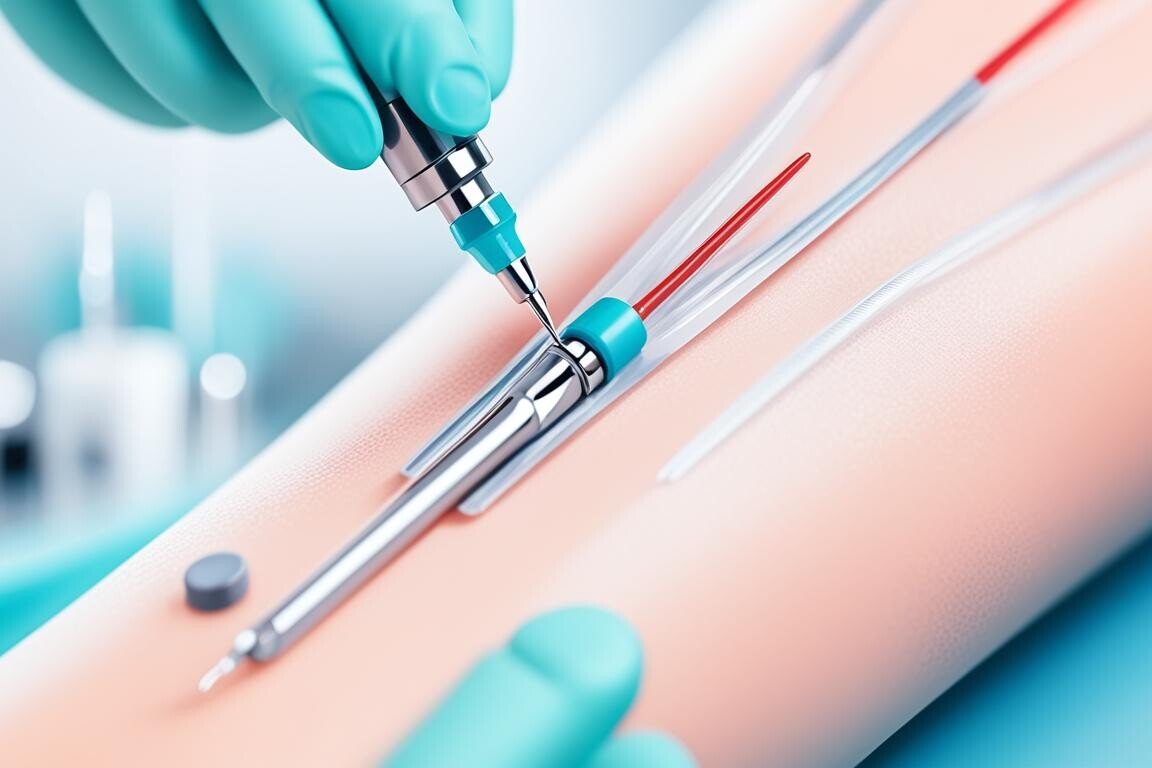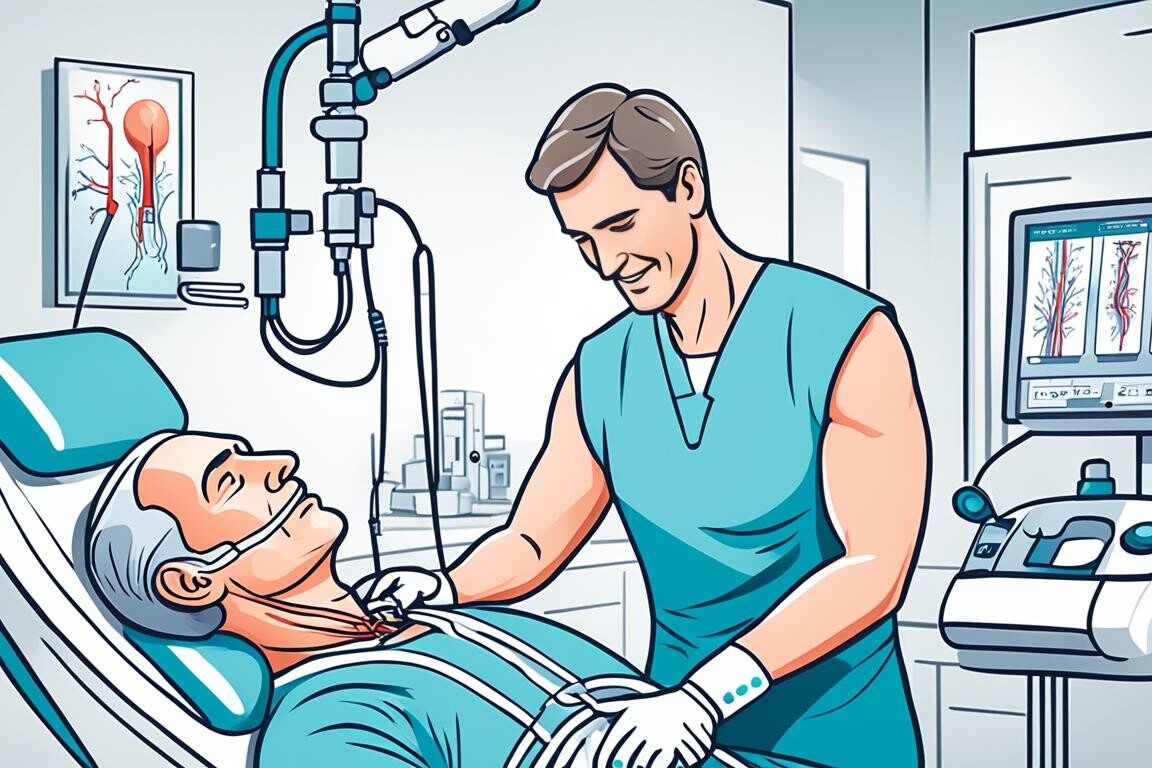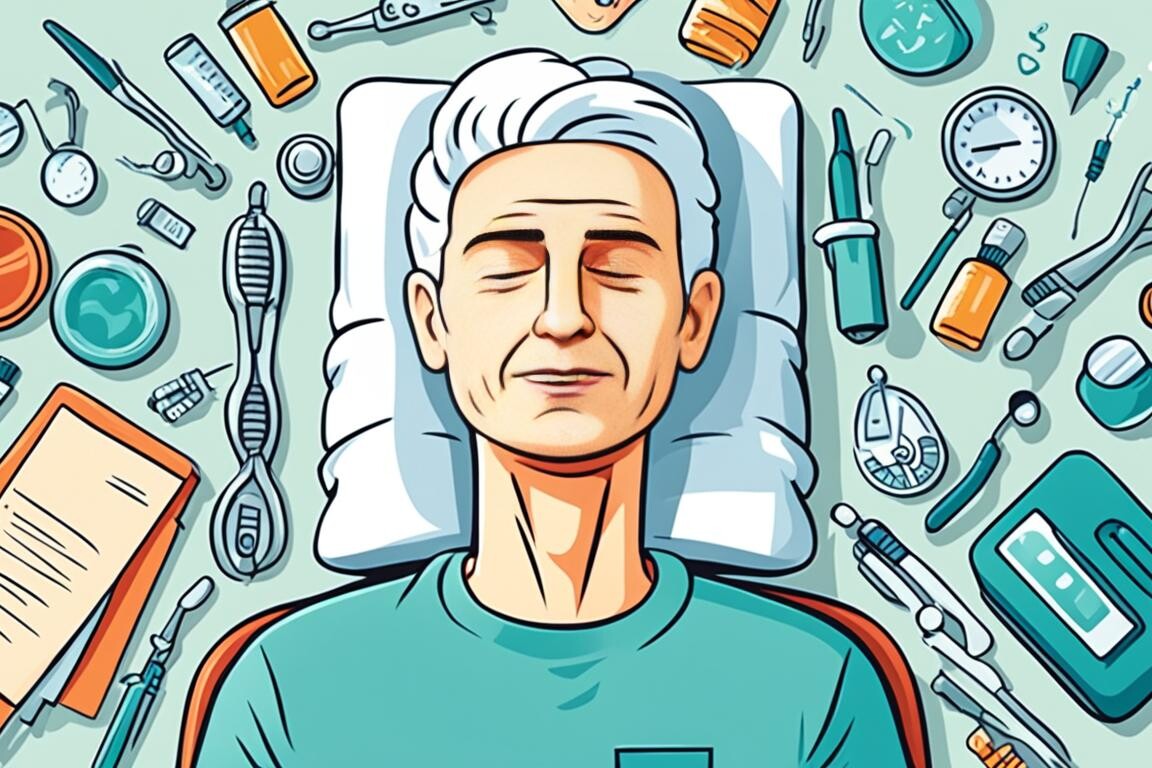Middle back pain, also known as thoracic spine discomfort, can really get in the way of your daily life. It can cause upper back ache, mid-back muscle tension, or pain in the mid-spine. But don’t worry, there are ways to get relief. This guide will show you the best strategies to ease your middle back pain and help you move freely again.
We’ll cover everything from self-care tips to exercises that target the right areas. You’ll learn how to ease interscapular pain, deal with rhomboid muscle strain, and reduce mid-back spasms and ache. With these strategies, you can take back control of your pain and live a life without discomfort.
Table of Contents
ToggleUnderstanding Middle Back Pain
Causes and Symptoms
The middle back, or thoracic spine, has 12 vertebrae (T1 to T12). It’s below the neck and above the rib cage. This area protects the spinal cord, which helps the brain talk to the body. Problems with bones, muscles, ligaments, and disks can hurt the nerves, causing pain.
Common causes of middle back pain are muscle strain, poor posture, injury, and more. Symptoms can be mild or severe, like muscle aches, burning, sharp pain, and stiffness. In serious cases, you might feel tingling, numbness, chest pain, weakness, or lose control of bowel or bladder.
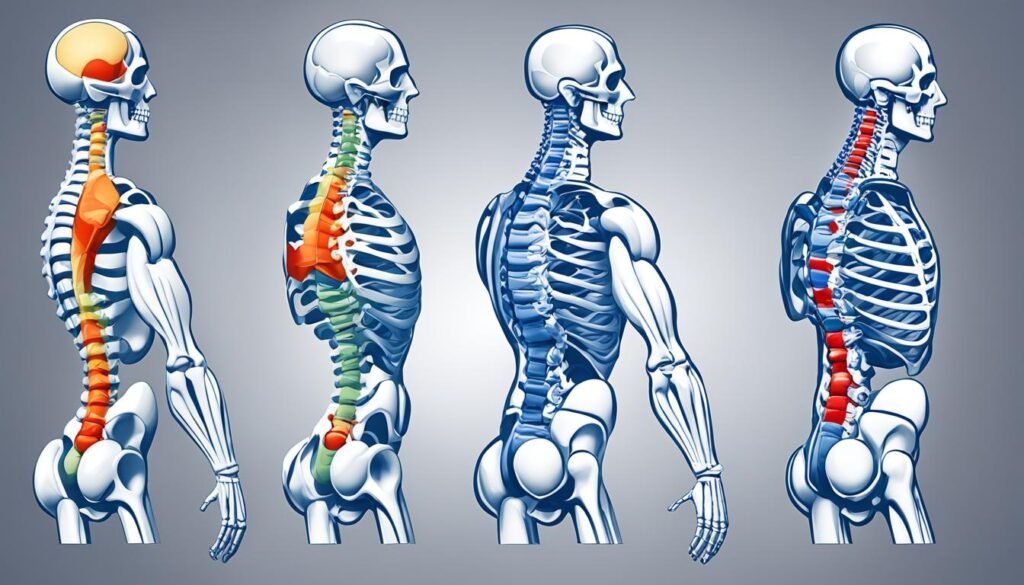
- Poor posture or slouching for a long time
- Muscle tension or imbalances in the mid-back
- Injury or trauma to the thoracic spine
- Degenerative changes like osteoarthritis or disc degeneration
- Osteoporosis causing vertebral compression fractures
- Being overweight and putting more stress on the spine
- Smoking, which can increase the risk of back pain
Knowing what causes middle back pain and its symptoms is key to finding relief and managing it.
Diagnosis and Evaluation
Finding out what’s causing your middle back pain is key to getting better. Doctors will do a detailed check-up to figure out the problem. They’ll then create a plan just for you. Let’s look at how they do this.
Your doctor will start by checking your spine, head, pelvis, and more. They might also test your nerves to see how they’re working. This helps spot issues like tight muscles, spine problems, or nerve issues.
Next, your doctor might order tests like X-rays, CT scans, or MRI scans. These tests show your spine in detail. They help find things like broken bones, disc problems, or other causes of middle back pain, thoracic spine discomfort, upper back ache, or mid-back muscle tension.
They might also take blood tests to check for other health issues that could be causing your pain. By using physical checks, tests, and lab results, doctors can find the main cause of your pain. Then, they can make a plan to fix it.
This careful check-up is important for making sure you get the right treatment. Your healthcare team will work with you to understand your symptoms, past health, and lifestyle. This helps them make a treatment plan just for you.
Home Remedies for Middle Back Pain Relief
Dealing with middle back pain can be tough, but you can try simple self-care at home. Using ice packs and heat pads, along with gentle stretches and exercises, can help ease the pain. These methods can make your thoracic spine and upper back feel better.
Simple Self-Care Techniques
Applying an ice pack to your back for 15-20 minutes several times a day can help. It reduces inflammation and numbs the pain. Then, switch to a heating pad or hot water bottle to improve blood flow and relax tight muscles.
Over-the-counter pain relievers like ibuprofen or naproxen can ease middle back pain. They reduce swelling and make you feel less uncomfortable. Gentle stretches and exercises, such as the seated twist and Child’s Pose, can also help.
Good posture is key to avoiding middle back pain. Stand up straight, keep your shoulders back, and take breaks from sitting. This can help prevent muscle strain and pain.

If your middle back pain doesn’t get better or gets worse, see a healthcare professional. They can find out what’s causing your pain and create a plan to help you.
Medical Treatments for Persistent Middle Back Pain
If home remedies don’t help your middle back pain in a few days, it’s time to see a doctor. They can figure out why your thoracic spine hurts and create a plan to fix it. This plan might include treating your upper back ache or mid-back muscle tension.
Your doctor might suggest some healthcare solutions based on how bad your pain is and what’s causing it:
- Physical therapy to strengthen your back muscles, improve flexibility, and teach proper posture and movement techniques
- Prescription pain relievers or muscle relaxers to manage the acute symptoms of your middle back pain
- Chiropractic care to realign the spine and alleviate pressure on the nerves
- Steroid injections to reduce inflammation and provide temporary pain relief
If less invasive medical treatments don’t work, your doctor might talk about surgery. This could be a laminectomy, laminotomy, or diskectomy to fix any structural problems.
It’s key to work with a healthcare professional to get the right clinical management for your pain. With the right middle back pain medical treatment, you can feel better and do what you love again.
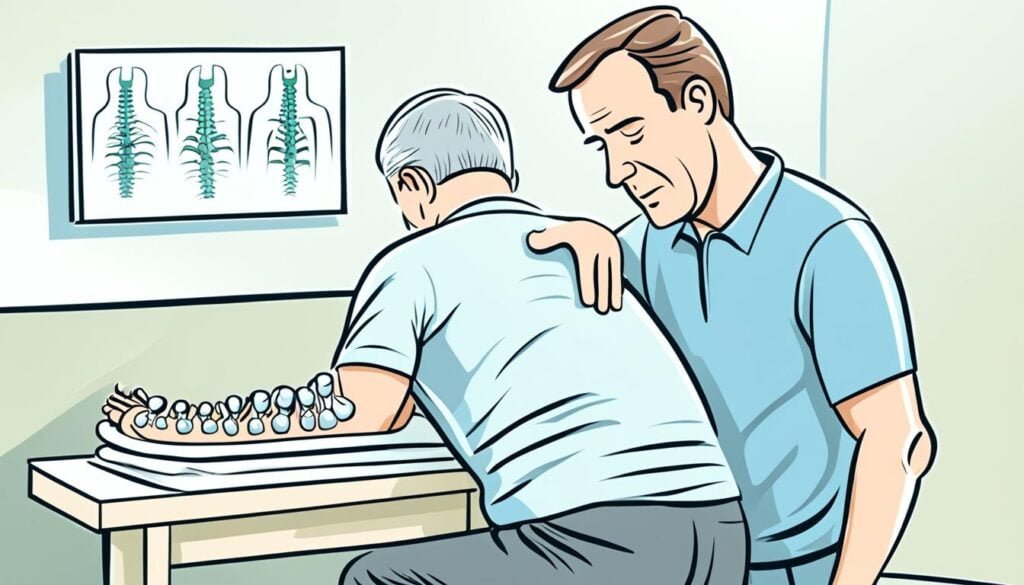
Surgical Options for Severe Cases
If conservative treatments don’t help with severe middle back pain, surgery might be an option. Doctors may suggest laminectomy, laminotomy, or diskectomy. These are for cases with structural problems like herniated disks or spinal stenosis.
Recovery from middle back pain surgery, thoracic spine discomfort operative treatment, upper back ache severe intervention, or mid-back muscle tension advanced procedures takes months. It’s needed for long-term relief and to help patients with severe pain.
- Laminectomy: Removal of the lamina to decompress the spinal cord
- Laminotomy: Partial removal of the lamina to alleviate a pinched nerve
- Diskectomy: Removal of part of a spinal disk to relieve nerve compression

These surgeries are for severe cases of middle back pain, thoracic spine discomfort, upper back ache, or mid-back muscle tension that don’t get better with other treatments. Surgery is chosen based on the patient’s condition, symptoms, and health.
Stretches and Exercises for middle back pain relief
Certain stretches and exercises can help ease middle back pain. They also improve flexibility and strengthen the muscles in the thoracic spine. Adding these to your routine can offer much-needed relief and support for your upper back health.
Yoga Poses and Stretches
Yoga has many poses and stretches that target middle back pain relief exercises and upper back ache yoga poses. Some good options include:
- Cat-Cow: Gently flexing and extending the spine to release tension.
- Downward-Facing Dog: Lengthens the thoracic spine discomfort stretches and strengthens the back muscles.
- Cobra Pose: Opens the chest and shoulders, relieving mid-back muscle tension mobility.
- Bridge Pose: Backbend that can help alleviate upper back pain.
Always talk to a healthcare provider before starting any new exercise. Some movements might not be right for your condition.

Other great middle back pain relief exercises are the seated twist, Child’s Pose, and Thread the Needle. These gentle stretches can help improve flexibility and reduce discomfort in the thoracic spine.
Adding stretching and strengthening exercises to your routine can support your middle back health well. Remember to listen to your body and adjust the intensity as needed to prevent further injury.
Lifestyle Adjustments for Prevention
Living a healthy life can help prevent middle back pain. Making a few simple changes can keep your thoracic spine strong and flexible. This reduces the risk of upper back ache and mid-back muscle tension.
Improving your posture is key. Don’t slouch or hunch over. Keep your shoulders back and your spine straight. Using a supportive chair and adjusting your computer screen can also help.
Being at a healthy weight and exercising regularly helps prevent middle back pain. Try low-impact activities like walking, swimming, or Pilates. These exercises strengthen your core and back muscles without straining your body.
Getting enough sleep and managing stress with techniques like meditation or deep breathing also helps. Smoking nicotine can limit blood flow to spinal disks, making back pain more likely.
By following these lifestyle tips, you can prevent middle back pain and keep your spine healthy and happy.
Key Lifestyle Tips for Middle Back Pain Prevention
- Improve posture by avoiding slouching and keeping shoulders back
- Maintain a healthy weight and engage in regular exercise, such as walking, swimming, or Pilates
- Get enough quality sleep and manage stress through relaxation techniques
- Avoid smoking, as nicotine can restrict blood flow to spinal disks
- Use proper ergonomics at work, including a supportive chair and adjustable computer screen
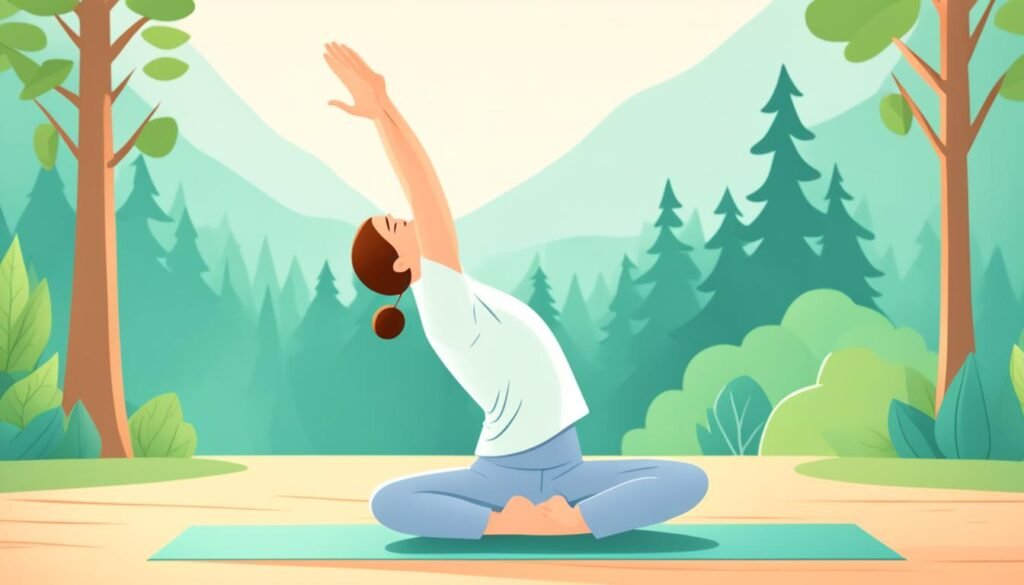
Complementary and Alternative Therapies
While traditional medicine is key for managing middle back pain, many find relief in complementary and alternative therapies. These natural remedies can be a big help, offering a holistic way to care for your thoracic spine and upper back.
Natural Remedies to Consider
Massage therapy is one option that might ease mid-back muscle tension. Creams with menthol or cannabidiol (CBD) can also numb pain receptors, helping with middle back pain.
Some people like using arnica for its anti-inflammatory effects. But always talk to your doctor before trying new supplements or therapies, especially if you have other health issues or take medicines.

Using complementary and alternative therapies can be a big help for middle back pain. By trying these natural remedies, you might find a better way to handle your thoracic spine and upper back issues.
When to Seek Professional Help
If you’re dealing with middle back pain, you might be able to handle it at home. But, there are times when you need to see a doctor. Knowing when to get help is key.
Most middle back pain can be fixed with simple treatments at home. But if the pain lasts over 72 hours, you should see a doctor. Signs like tingling, numbness, weakness, or losing control of your bladder or bowels mean you need help right away.
If your back pain comes on suddenly and is very bad, get help fast. This could mean you have a serious issue like a broken bone or spinal cord injury. These need quick medical care.
- Persistent middle back pain lasting more than 72 hours
- Tingling, numbness, or weakness in the limbs
- Loss of bladder or bowel control
- Sudden, severe back pain after an injury or accident
If you notice any of these symptoms, see a middle back pain doctor. They can figure out what’s causing your pain and help you get better. This can also prevent more problems later.
Middle back pain relief Strategies Tailored to Your Needs
Finding relief for your middle back pain requires a personalized approach. The best treatment depends on the cause of your pain, your age, health, activity level, and what you prefer. With a healthcare provider’s help, you can create a plan that meets your specific needs for middle back pain relief.
Your healthcare provider might suggest home remedies, physical therapy, medication, or surgery for severe cases. If your pain comes from poor posture or work setup, they might recommend exercises to fix your posture and strengthen muscles. For pain linked to conditions like a herniated disc or kidney stones, you might need specific treatments like painkillers or procedures.
It’s important to work with your healthcare provider to create a personalized middle back pain relief plan. This plan should tackle the main cause of your thoracic spine discomfort and help you manage your mid-back muscle tension effectively.
Maintaining a Healthy Back
Preventing middle back pain is key for your long-term thoracic spine discomfort wellness and upper back ache long-term care. After fixing any mid-back muscle tension, focus on healthy habits. This means practicing good posture, doing exercises for your core and back, and stretching every day.
It’s also important to keep a healthy weight and sleep well to avoid middle back pain. Plus, be aware of your work setup and take breaks to avoid putting strain on your thoracic spine.
- Prioritize good posture throughout the day
- Engage in regular exercises to strengthen your core and back muscles
- Incorporate daily stretching and mobility exercises
- Maintain a healthy weight to reduce strain on your spine
- Ensure you get enough quality sleep each night
- Pay attention to ergonomics at work and take regular breaks
By following these habits, you can lower the chance of getting middle back pain again. This way, you can keep your spine healthy for life. Always talk to a doctor before starting new exercises or big changes in your life.
Conclusion
Middle back pain, found in the thoracic spine, is common and can be managed. Knowing the causes, like poor posture or injury, helps you take steps to ease the pain. It’s important to notice the symptoms, get medical help, and use home remedies and self-care.
If your pain is from muscle tension, joint issues, or health problems, a full approach can help. This includes exercises, stretching, and changing your lifestyle. Keeping a good posture, staying active, and getting professional advice can help manage your pain and prevent future issues.
The key takeaways are that middle back pain is common and can be handled with self-care and medical help. By understanding the causes, symptoms, and treatments, you can make a plan to ease your mid-back muscle tension. This will help improve your overall back health and well-being.
FAQ
What causes middle back pain?
Middle back pain can come from poor posture, injuries, health issues, or aging.
What are the symptoms of middle back pain?
Symptoms include muscle aches, dull pain, and burning sensations. You might also feel sharp or stabbing pain, muscle tightness, or numbness in your limbs. In severe cases, you could have chest pain, weakness, or lose control of bowel or bladder.
How is middle back pain diagnosed?
Doctors use a physical exam and tests like X-rays, CT scans, MRI scans, and neurological tests to find the cause of middle back pain.
What are some home remedies for middle back pain relief?
You can try using ice packs and heat pads, taking over-the-counter pain meds, and doing gentle stretches and exercises at home to relieve middle back pain.
When should I seek medical treatment for middle back pain?
If home remedies don’t help after 72 hours, or if you have sudden, severe pain after an injury, you should see a doctor.
What are some medical treatments for persistent middle back pain?
Doctors might suggest physical therapy, prescription pain meds, chiropractic care, or steroid injections if home remedies don’t work.
What are the surgical options for severe middle back pain?
For severe pain, surgery like a laminectomy, laminotomy, or diskectomy might be recommended if other treatments don’t work.
What stretches and exercises can help relieve middle back pain?
Helpful stretches include the seated twist, Child’s Pose, Thread the Needle, and yoga poses like Cat-Cow, Downward-Facing Dog, Cobra Pose, and Bridge Pose.
How can lifestyle adjustments help prevent middle back pain?
Improving your posture, staying at a healthy weight, exercising regularly, sleeping well, and managing stress can help prevent middle back pain.
What complementary and alternative therapies can help with middle back pain?
Massage therapy, topical creams with menthol or CBD, and natural remedies like arnica can offer relief for middle back pain.
Source Links
- 19 Exercises for Upper Back Pain, Neck Pain, Tight Shoulders
- Best Mid Back Stretches and Exercises for Back Pain – BenchMark Physical Therapy
- 10 Daily Habits To Stop Back Pain
- 10 alternative back pain treatments to try before choosing surgery | Orthopaedics and Rehab | UT Southwestern Medical Center
- Treating back pain without surgery: 11 alternative treatment options
- When Can a Doctor Help Your Back Pain?
- Back pain: Symptom When to see a doctor
- Middle Back Pain on Left-Side: Morning Relief Guide
- 6 Ways to Improve Your Back Pain
- Taking care of your back at home: MedlinePlus Medical Encyclopedia
- 16 Ways to Avoid Back Pain
- 10 Tips For Dealing With Lower Back Pain
- Middle Back Pain – Massage & Stretches For Relief
- Understanding and Managing Middle Back Pain: Causes, Symptoms, and Treatment – Singapore Paincare Center
- 7 Exercises to Relief Upper & Middle Back Pain | QI Spine
About The Author

This article is medically reviewed by Dr. Chandril Chugh, Board-Certified Neurologist, providing expert insights and reliable health information.
Dr. Chandril Chugh is a U.S.-trained neurologist with over a decade of experience. Known for his compassionate care, he specializes in treating neurological conditions such as migraines, epilepsy, and Parkinson’s disease. Dr. Chugh is highly regarded for his patient-centered approach and dedication to providing personalized care.
→ Book a consultation to discover which remedies suit your needs best.


